Competitive intelligence teams are always small. Teams of one are the norm. And in many businesses, that one person performs competitive intelligence alongside a bunch of other responsibilities.
When a team of two is a luxury, how great would it be to have an assistant take care of menial tasks for you? Enter ChatGPT.
For a low-cost tool (or a free one, depending on which version you’re using), ChatGPT is extraordinarily capable. Sure, it’s not perfect, but what human assistant is perfect?
In this article, we’ll walk you through seven of the best ways you can use ChatGPT right now to help lighten the competitive intelligence load. We’ll also walk you through how to improve ChatGPT’s responses if it’s proving tricky to get what you need with your use case.
Let’s get cracking. 👏
What is ChatGPT?
ChatGPT is a generative AI language model (the “GPT” stands for “generative pre-trained transformer”.) Through natural language processing (NLP) it can process and interpret written text.
Machine learning AI models like ChatGPT are trained on large sets of data. With large enough data sets, they’re able to draw out more and more accurate patterns between variables, and “learn” a lot about the interplay between those variables.
What makes ChatGPT stand out (especially its newest GPT4 iteration) is (i) the sheer size of the data set OpenAI trained it on, and (ii) its chatbot interface.
You just ask it questions, or tell it to do something, and it responds with (usually) accurate, competent answers that’d rival those a human expert could give. This has democratized access to a highly competent machine learning model with countless practical applications.
Ways to use ChatGPT to save time and resources in competitive intelligence
So… how would you use ChatGPT in competitive intelligence?
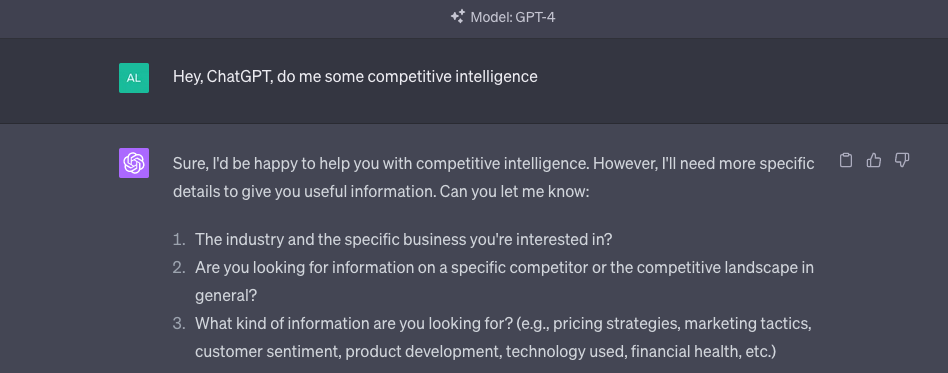
There are some restrictions and pitfalls to be aware of, which we’ll discuss later. For now, here are seven ways you can use ChatGPT to help with your competitive intelligence duties.
1 - Creating survey questions
You may or may not want to assign ChatGPT any heavy-duty analysis. Instead, give it your menial tasks.
Need to spin up some survey questions for a new bout of customer research? Have ChatGPT help.
Having trouble with your current win/loss surveys? Enlist ChatGPT to give them a refresh.

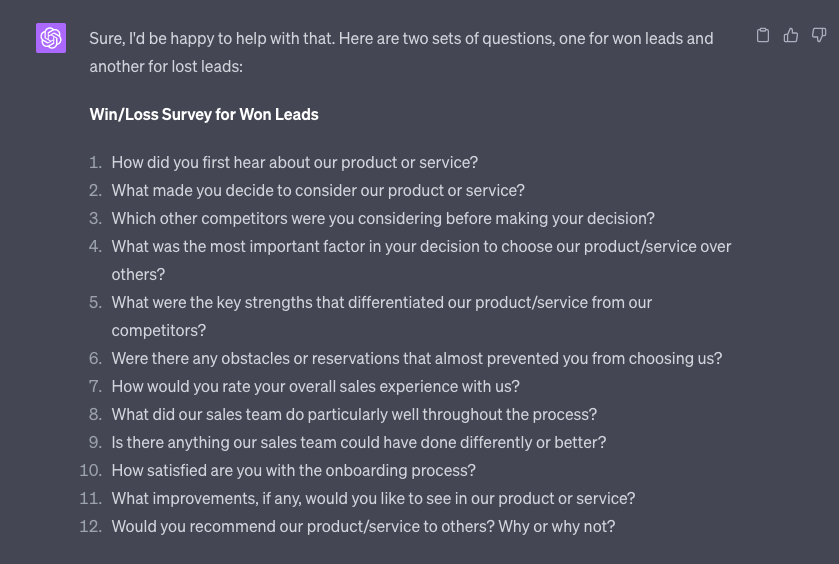
2 - Summarizing reams of written intel
When there’s a competitive development, and you want to get up to speed quickly, ChatGPT can help.
Here are some awesome sources of competitive intelligence:
- Help documents.
- Marketing material.
- Blog posts.
- Google Alerts.
- Social media posts.
But imagine having to sift through new entries to each of those categories every day. Talk about overwhelming. And that’s only a very small list of possible sources.
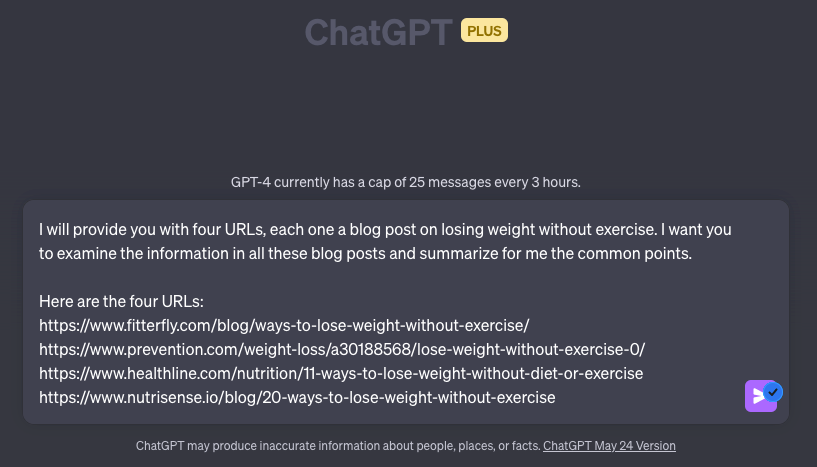
ChatGPT can just summarize this information for you. Paste the information from multiple sources across multiple prompts, and ask ChatGPT to summarize the lot.
3 - Identifying trends and common themes in written and numeric data
You might think that, because ChatGPT is a language model, it can only interpret written data.
Not so fast!
ChatGPT can also interpret code, and respond with code snippets. This means it can use its understanding of a wide range of programming languages to interpret tabular data too. That includes numeric data.
If you’re skilled with Excel or Google Sheets, or even with Python’s data analysis libraries like Pandas, ChatGPT won’t be able to do anything you can’t do yourself. But it might save you some time and mental bandwidth that’d be better used on another pressing task.
Maybe you’ve got transcripts of interviews with your internal subject-matter experts, or qualitative data from customer interviews. Perhaps you’ve got some competitor pricing data or the projected value of upcoming deals (both numeric). ChatGPT can interpret this data and draw out its hidden trends and common themes for you.

4 - As a sense checker for your own reasoning and conclusions
This use case might be the most important in this list.
Use ChatGPT to search for flaws in your reasoning. Use it to sense check your analysis.
In his book, Principles, billionaire investor Ray Dalio talks about creating algorithms to run your decision-making process alongside you. When you reach what you deem a sensible conclusion, you check the algorithm’s conclusion against your own. If they match, great. If not, maybe there’s a flaw in your reasoning.
ChatGPT saves you from having to be a programming wizard (or having one work for you). And, rather than handing the reigns of responsibility over to an AI, this approach has it work alongside you to catch your mistakes and lift the overall quality of your decision-making.
Even better, if you’re having trouble with a problem, talk through it step by step with ChatGPT and ask it to look for logical flaws in your reasoning. Or to suggest solutions you might not have thought of.
5 - Strategic suggestions
Data is great, but it’s the reasoning you do as the analyst that makes it useful and valuable to your organization.
Since that analysis is so valuable, why do it all by yourself? If ChatGPT can draw out trends and common themes across data, it can also advise you on the best strategic next steps to take in light of what you’ve learned from that data.
The key here, as with everywhere else, is ChatGPT can only advise. It doesn’t have all the background on the business you do, no matter how much information you provide in your prompts.
To help get the creative juices flowing, though, there are few easier ways to start a brainstorming session than asking ChatGPT for its thoughts.
6 - To draft deliverables
A lot of working with stakeholders comes down to taking information in one form and transforming it into another form. A form you’ve agreed upon with the stakeholder group.
This could be battlecards for your sales and customer success teams. Or competitive news briefings to keep the whole business up to date.
Whichever it is, you’ve done the hard part in getting the information you want. The time-consuming part is converting the info into these different forms.
Just like ChatGPT can draft articles, survey questions, or presentation slides, it can also draft your deliverables for you.
You can even give it the template you use, and the information, and it’ll draw you up a solid draft in seconds.
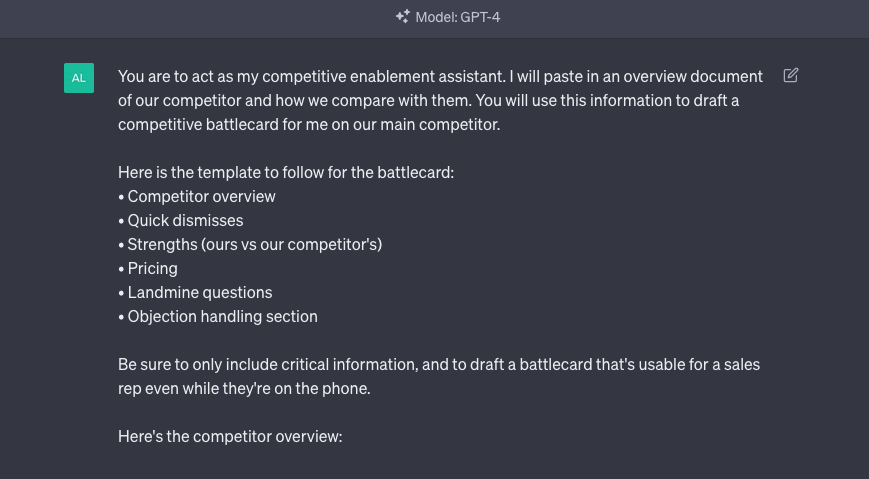
7 - To reduce context-switching
There’ll always be more work to do than you could possibly ever actually get done. But an AI assistant that can perform tasks for you allows you to retain your focus where it’s most needed. And therein lies the beauty of ChatGPT.
By taking care of more menial tasks, you retain focus. You can batch these tasks together and have ChatGPT perform all of them. Rather than draining your mental resources, you use ChatGPT’s. This leaves more fuel in your tank for those deep work tasks that really matter.
When you’re confident you can deal with these small tasks in batches and on time, you’re more confident in soldiering on with those important tasks when you’re focused. This’ll reduce context-switching and make you more effective, productive, and impactful in your role.
Things to be wary of
ChatGPT won’t list its sources.
ChatGPT won’t list its sources because it’s not pulling from a single source. It’s not even pulling from five, or even 10 or 20 sources. ChatGPT has been trained on a massive data set, and the amalgamation of that vast number of sources forms the single “source” for each of its answers.

If critically examining the quality of each data source is an essential element in competitive analysis, then simply asking ChatGPT for a direct answer can never be the way forward.
Instead, give ChatGPT specific tasks. Instead of treating it like an oracle with the answers to everything, treat it like a capable, but inexperienced assistant.
ChatGPT is not a competitive advantage
Using ChatGPT doesn’t constitute a competitive advantage. (Although refusing to use it at all might constitute a competitive disadvantage.)
Why is that?
Establishing a competitive advantage boils down, more often than not, to being willing to do what others are not.
Longer, more arduous training sessions hone athletes beyond the level of their more laid back teammates.
When all the top athletes in a sport are using performance enhancing drugs, you’d have to use them too to level the playing field. But it’ll always be what you do differently that determines whether you stand a chance of winning.
Similarly, when it comes to competitive strategy, using ChatGPT might level the playing field for you and stop you falling behind. Even then, you’ll still need to work smarter and harder than the rest to come out on top.
FAQs
Will ChatGPT make competitive intelligence a redundant discipline?
No. The value of competitive intelligence as a role is not in simply collecting data. It’s in having a deep understanding of both the business you work in and the industry and its competitive landscape. From there, you must ask the right questions to uncover meaningful analysis. You must also work to enable and support diverse sets of stakeholders.
How do I know ChatGPT’s answers are accurate?
You don’t. Always assume that ChatGPT could be wrong. Sense check all of its answers, and use it as one more input in your process.
Do I need to pay to use ChatGPT for competitive intelligence?
ChatGPT’s latest and greatest iteration, GPT4, is still only available to paid users at the time of writing. The slightly older (but still very capable) iteration, GPT3.5, is available for free users.
What competitive intelligence tasks can ChatGPT do?
ChatGPT can help you draft survey questions for data collection, deliverables for your stakeholders, and can even summarize your intel once you’ve collected it. It can also identify trends and themes within your data, and help you sense check your reasoning and analysis.
Need help with competitive intelligence?
Does your competitive intelligence program leave something to be desired?
Imagine if you could:
- Set up your listening stack to gather competitive intel with ruthless efficiency, giving you more time to analyze, enable, inform, and become your business’s champion. 💪
- Set up win/loss interviews to unveil the powerful reasons why customers aren’t choosing you, even if you’ve got no time or resources. 🔎
- Deliver a competitive news briefing that gets people talking, no matter which set of stakeholders you serve. 📣
We’ve got a brand new course that covers every aspect of competitive intelligence, and what it takes to be successful.
Interested? Click below right now to check it out.
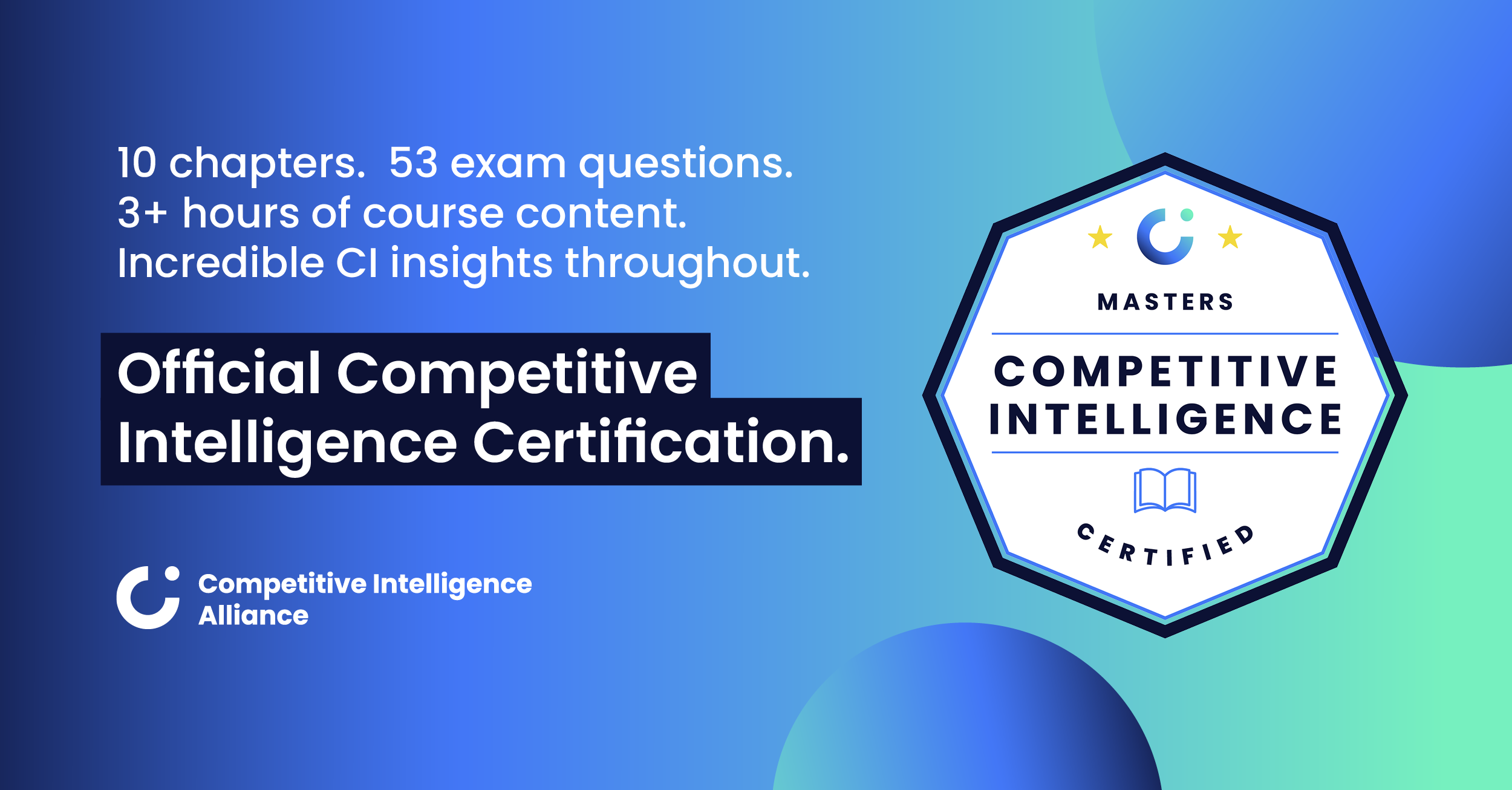





.png?v=a38c2de9f4)